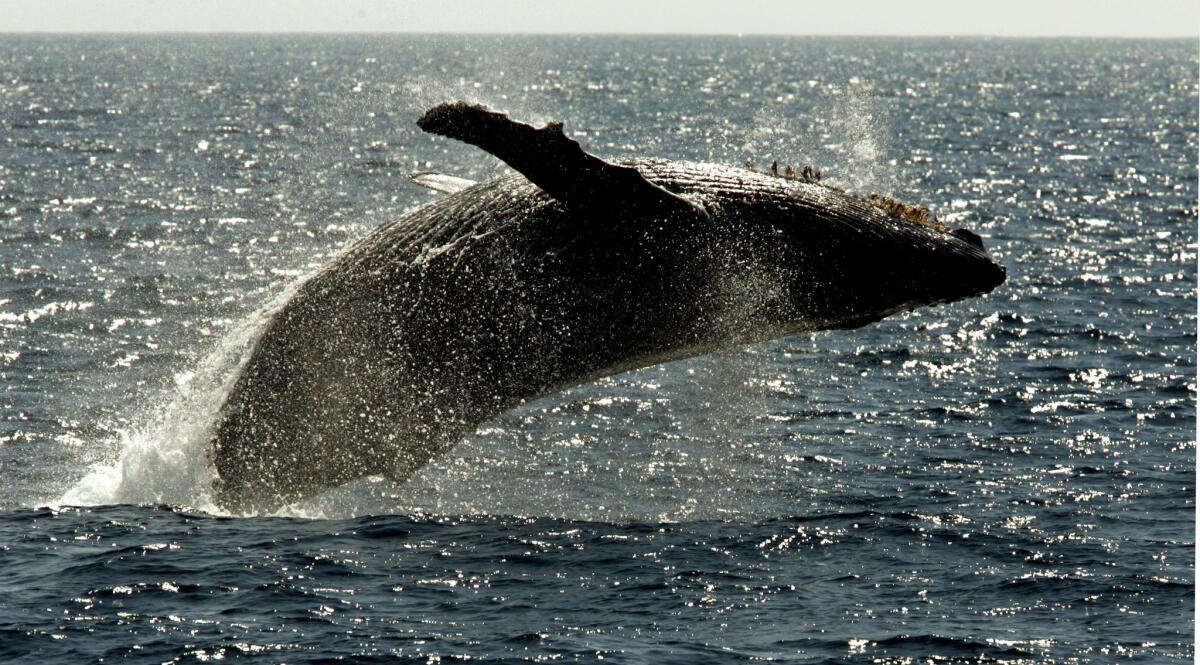Navy agrees to restrict offshore training to protect marine mammals

A humpback whale leaps out of the water off Maui. To settle a lawsuit brought by environmental groups, the Navy agreed Monday to rule certain areas off-limits to training near Southern California and the Hawaiian islands.
The Navy has agreed to curtail its use of sonar and underwater explosives during training exercises in key marine mammal habitat off Southern California and Hawaii.
The settlement brings an end to legal challenges against the government from environmentalists — led by the Natural Resources Defense Council and Earthjustice. It was signed Monday by U.S. District Judge Susan Oki Mollway in Honolulu.
In April, Mollway ruled that the National Marine Fisheries Service had violated federal environmental laws when it decided the Navy’s training would have a “negligible impact” on whales, dolphins, seals, sea lions and sea turtles.
That set off months of negotiations between the Navy, the fisheries service and the environmental groups.
“By agreeing to this settlement, the Navy acknowledges that it doesn’t need to train in every square inch of the ocean and that it can take reasonable steps to reduce the deadly toll of its activities,” said Earthjustice attorney David Henkin.
The Navy’s testing plan could have proved disruptive to feeding areas, migratory corridors and places where the animals reside, he said.
A spokesman said the Navy agreed to the settlement because it faced “the real possibility that the court would stop critically important training and testing.” Lt. Cmdr. Matt Knight, spokesman for the U.S. Pacific Fleet, said that “the Navy has been, and will continue to be, good environmental stewards as we prepare for and conduct missions in support of our national security.”
The litigation centered on a disagreement about how many marine mammals might be harmed by the Navy’s training regimen. Mollway ruled that the Navy had vastly underestimated the threat.
According to the environmentalists, the settlement calls for a ban on mid-frequency sonar and explosives on the eastern side of the Big Island and north of Molokai and Maui, in an effort to protect whales and Hawaiian monk seals. Surface ships would be required to use “extreme caution” to avoid hitting humpback whales.
Off Southern California, the Navy is banned from using mid-frequency sonar between Santa Catalina Island and San Nicolas Island, also near blue whale habitat off San Diego, the environmental groups said. The same extreme caution would be required for ships in the feeding habitat and migratory corridors for blue, fin and gray whales.
The Navy asserted its training could kill 155 whales over five years. Environmentalists said the number of those killed or injured would be much higher.
Among other things, the Navy uses sonar to teach sailors how to detect “super quiet” submarines that can operate in relatively shallow near-shore areas.
Though the military would have preferred a less-restrictive agreement, Knight said, “this … preserves critically important testing and training.”
Bill Rossiter, executive director for advocacy, science and grants at Cetacean Society International, said the agreement means “beaked whale populations in Southern California that have been suffering from the Navy’s use of sonar will be able to find areas of refuge where sonar will be off-limits.”
The new restrictions will be applied under the Marine Mammal Protection Act.
Twitter: @LATsandiego
ALSO:
Bystander with cellphone shot by deputies in Sacramento County
Brother of American killed fighting for ISIS is charged with lying to FBI
Inglewood courthouse evacuated after possibly hazardous materials found in envelope
More to Read
Sign up for Essential California
The most important California stories and recommendations in your inbox every morning.
You may occasionally receive promotional content from the Los Angeles Times.










